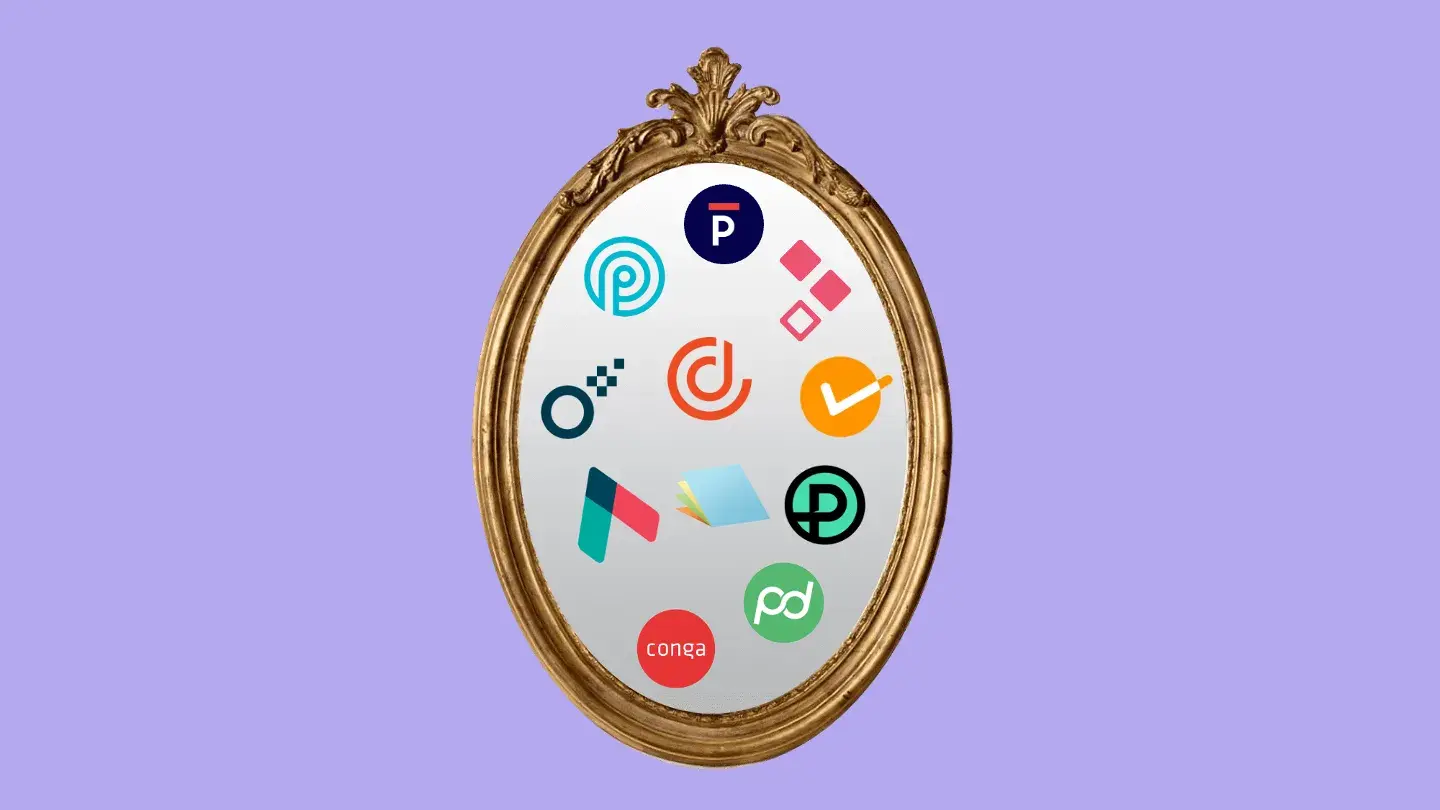Enterprise sales has never been more complex. With longer buying cycles, expanded stakeholder groups, and growing pressure to demonstrate ROI at every stage, sales leaders are rethinking how their teams operate.
Proposal software has emerged as a key lever – not just for improving efficiency, but for enabling smarter selling, deeper buyer engagement, and tighter alignment across revenue teams.
This article outlines the most common friction points in enterprise sales, and the specific ways proposal software helps resolve them.
1. Messy, inconsistent sales processes
The pain:
When every sales rep creates proposals their own way, you lose control. Content ends up scattered across SharePoint folders, Slack threads, and personal drives. Branding becomes inconsistent. Legal-approved terms get copy-pasted incorrectly. And onboarding new reps? A logistical nightmare.
Even experienced sellers waste time rebuilding decks or tracking down the "latest version" of that one case study. The result? Frustrated reps, bloated sales cycles, and a poor buyer experience.
How proposal software helps:
Proposal software brings order to the chaos with centralized tools and reusable components. Sales leaders can enforce consistency while giving reps the flexibility to tailor proposals to each opportunity.
Key features that help:
-
Centralized content library for up-to-date, approved materials
-
Branded templates that maintain visual and legal consistency
-
Guided workflows to help new reps ramp faster
-
Role-based access and version control for compliance
The result:
Proposals get created faster, with fewer errors and more impact – and every rep looks like a pro, even on day one.
2. Overreliance on a single champion
The pain:
In complex deals, it's common to have one internal advocate. But when your whole strategy hinges on that person forwarding the proposal or presenting your value to the buying committee, you’re playing a dangerous game.
What happens when they’re out of office? What if they don’t have influence with finance? What if they simply forget to forward your deck? This lack of visibility can stall deals or kill them entirely – and you may never know why.
How proposal software helps:
Proposal platforms enable direct engagement with all stakeholders. You can see who’s viewed the proposal, when they opened it, and what they focused on – so you can adjust your strategy accordingly.
Read more about stakeholder management with proposal software >>
Key features that help:
-
Digital sales rooms that host all deal materials in one shared space
-
Engagement analytics by individual viewer
-
Multi-stakeholder access with tracking
-
Mutual action plans to align next steps across teams
The result:
You build momentum across the buying group, de-risk deals, and stop relying on a single thread to hold the deal together.
See how proposal software can streamline your enterprise sales process
3. Long, slow sales cycles
The pain:
Enterprise deals are long – but they often drag longer than they need to. One of the biggest culprits? Proposal creation. Reps spend hours (sometimes days) customizing documents, chasing approvals, and tweaking formatting.
And after all that work? They send a PDF and hope for the best. With no insight into what resonates, follow-ups are generic, poorly timed, and less effective.
How proposal software helps:
Proposal software automates repetitive tasks and gives sellers visibility into buyer behavior. You’ll know who’s engaged, what sections matter, and when to reach out – all while cutting proposal time in half.
Key features that help:
-
Customizable templates with dynamic fields
-
Drag-and-drop proposal builder
-
Real-time engagement tracking (views, clicks, time on page)
-
Smart notifications to alert reps to buyer activity
The result:
Less time spent building proposals. More time engaging buyers. And deals that move forward faster – with fewer dead ends.
Buyer enablement bonus:
Proposal software doesn't just help sellers. It empowers buyers. With all key documents, timelines, and answers in one place, stakeholders can drive conversations more easily, accelerate decisions without added pressure from sales.
|
4. Poor buyer experience
The pain:
In enterprise deals, your proposal is your brand. A clunky PDF with generic content and no interactivity doesn’t inspire confidence. Worse, buyers have to dig through long documents to find what matters – often leading to confusion or disengagement.
Buyers today expect clarity, personalization, and ease. And if they don’t get it from you? They will from your competitor.
How proposal software helps:
With proposal software, your documents become polished, interactive, and tailored to the buyer's priorities. You guide the narrative, making it easier for stakeholders to align and say yes.
Key features that help:
-
Interactive proposals with personalized sections
-
Embedded media (video intros, demos, timelines)
-
Commenting and Q&A directly in the proposal
-
Mutual action plans to show what’s next
The result:
A smoother, more engaging experience that gets stakeholders aligned and builds confidence in your solution.

"We were looking for a solution to allow us to use videos to engage prospects, send trackable sales materials, forward proposals, and gather signatures on contracts - all within our CRM. GetAccept was the answer."
Germain Brion SVP Corporate Strategy, Chargebee
5. Siloed tools and broken workflows
The pain:
If your CRM, content tools, and proposal process don’t talk to each other, your reps are stuck doing manual work. That means copy-pasting data, double-checking prices, or chasing down the latest assets – none of which help close deals.
And without engagement data feeding back into your systems, your sales insights are incomplete, and your forecasting is fuzzy.
How proposal software helps:
Modern proposal platforms integrate directly with your CRM and content systems, automating busywork and surfacing insights where they matter most.
Key features that help:
-
Native integrations with CRMs like Salesforce, HubSpot, or Dynamics
-
Sync with content repositories (e.g. Google Drive, SharePoint)
-
Real-time data capture and syncing to opportunity records
-
Single sign-on and access controls for security
The result:
Less admin. More selling. And a clear line of sight into buyer engagement across the deal cycle.
6. Incomplete reporting and forecasting blind spots
The pain:
You know deals are slowing down — but you don’t know why. Sales managers and RevOps teams often struggle to understand what’s happening after a proposal is sent. Which deals are warm? Who’s engaged? What’s sitting idle? Without clear data, forecasting becomes guesswork, and pipeline reviews turn into opinion-fests instead of decision-making sessions.
Manual check-ins aren’t scalable, and static PDFs don’t tell you what’s working. It’s hard to double down on what moves the needle if you can’t measure it.
How proposal software helps:
Modern proposal platforms surface real-time engagement data, mapped directly to each deal. Managers can quickly spot red flags (like ghosted proposals) or positive signals (like multiple stakeholders reviewing content). Proposal insights flow back into the CRM, supporting more accurate forecasts and coaching conversations.
Key features that help:
-
Deal-level analytics (opens, views, time spent, shares)
-
Stakeholder mapping and engagement tracking
-
CRM sync for full pipeline visibility
-
Reporting dashboards for content and proposal performance
The result:
Better forecasting. More informed pipeline reviews. And visibility that helps sales leaders coach reps, prioritize deals, and allocate resources strategically.
Is your team ready for proposal software?
10 signs it’s time to upgrade your enterprise sales process:
The sign |
Description |
| 1. Content chaos | Your team wastes time hunting for the latest decks, legal terms, or customer case studies across a patchwork of tools. |
| 2. No engagement visibility | Once proposals are sent, it’s radio silence. You have no idea if key stakeholders have even opened them. |
| 3. Sales cycles are bloated | Deals regularly stall or slip into next quarter – and you’re left guessing where they broke down. |
| 4. No standardized proces | Every rep builds proposals their own way, leading to inconsistent messaging, branding, and compliance risk. |
| 5. Overreliance on a single champion | You’re depending on one internal contact to forward your materials and pitch your value — often with no oversight. |
| 6. Buyers get clunky PDFs | Proposals are static, long, and hard to navigate — offering little flexibility or interactivity for buyers trying to make a decision. |
| 7. Hard to personalize at scale | Tailoring proposals for different stakeholders, regions, or segments takes too long — or just doesn’t happen. |
| 8. Poor internal collaboration | Sales, legal, marketing, and product teams aren’t aligned on what's included in proposals or what’s allowed. |
| 9. Reporting is reactive, not strategic | You can’t confidently answer which proposals are live, who’s most engaged, or what content wins deals. |
| 10. Your tech stack doesn’t talk | Your CRM, content library, and proposal process are disconnected — forcing reps to do manual admin and context switching all day. |
Proposal software meets the moment
Enterprise sales isn’t broken – but it is under pressure. Long cycles, disconnected teams, and hard-to-reach stakeholders are making it harder than ever to sell effectively at scale.
Proposal software gives enterprise teams the structure, visibility, and speed they need to adapt. From streamlined workflows to smarter engagement, these tools aren’t just helping sales teams move faster – they’re helping them win more.
Interested? Here's a rundown of the best proposal software in 2025.



